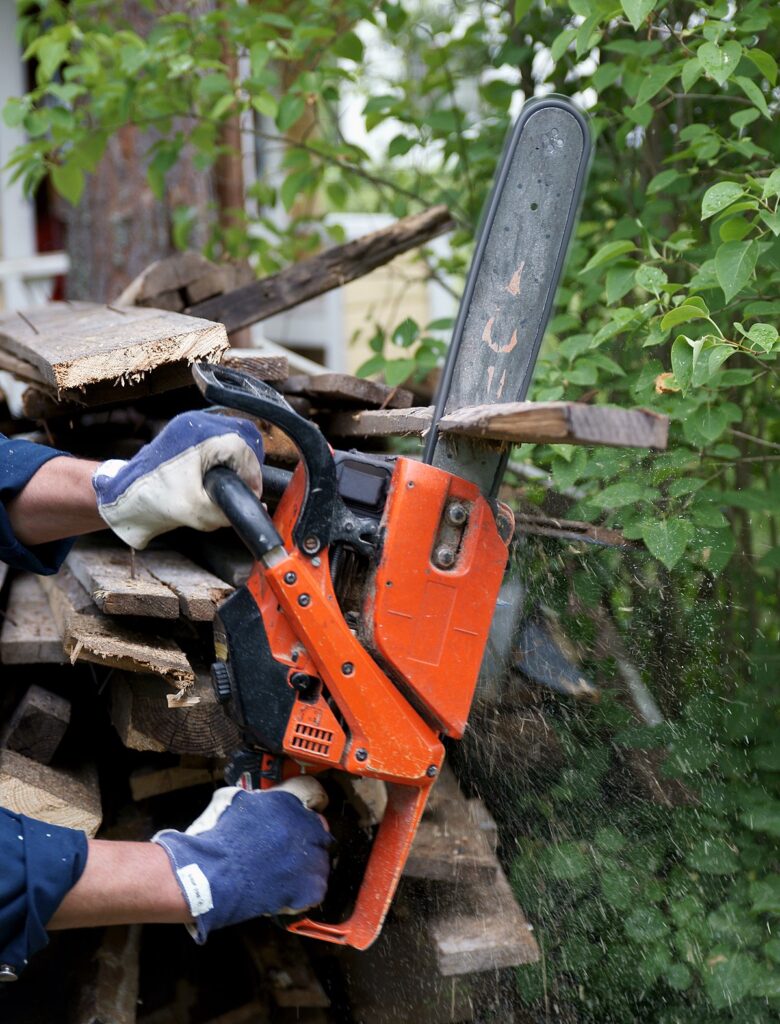Every tool has the capacity to cause harm in some way. Hammers can crush thumbs, and slipping wrenches can result in skinned knuckles, but chainsaws raise the stakes in terms of possible harm. We’re talking about blindingly fast, razor-sharp metal teeth that are frequently only a few inches away from the saw operator’s body.
Small chunks of wood are spit out by saws at a rapid rate. Branches may jump back when severed like a rifle shot because they are often under extreme tension. At best, a poorly cut tree can flatten that bed of petunias; at worst, it can crush you.
It takes practice to become proficient with a chainsaw and requires talent to use one neatly and securely.
Every situation when using a chainsaw is different, and understanding each of these special situations increases your ability level much like going through a practical chainsaw operator’s training would.
Basics of safely utilizing chainsaws –
Devices for personal protection.
Let’s begin with the fundamentals: your PPE, or personal protective equipment. Wearing eye protection, ear protection, decent, sturdy boots, long pants, a long-sleeved shirt, gloves, and chainsaw chaps is very necessary if using a chainsaw.
A hard hat is a smart choice, especially when felling—laying an upright tree on the ground. Yes, wearing full protective equipment may seem excessive if all you plan to do is cut up a few limbs that fell during last night’s strong winds, but negligence can have tragic consequences.
Establishing a secure environment.
Check the environmental safety of the unique circumstances before you start any cutting. Always look up, glance down, and around when falling.
Is there a way for you to get away if the tree falls? Does the tree have a clear path to fall? What would happen if it went in the wrong direction—would it hit the power line or the doghouse? Is the tree sick or plagued with bugs? Do you want the tree to fall in that direction? Is the wind blowing in that direction?
In the end, be honest with yourself about whether you feel confident performing the current sawing task. Don’t be afraid to answer “no.”

Using the saw
Limbing, bucking, and felling are the three main divisions of chainsaw operations. The act of limbing involves removing limbs from a fallen tree. Cutting the downed tree’s trunk to length is known as bucking. Additionally, felling is the controlled chopping of an upright tree to cause it to fall in the intended location.
It might seem apparent, but every time you use the saw, even if you only plan to cut for a short while, fill both the gas and bar oil reservoirs. To make sure that the saw’s lubricating oil never runs out while it is being used, it is a good practise to form.
If you need some ideas about what to read next, here they are:
- Planning to buy a lawnmower, know the ideal time.
- What is a good grass trimmer?
- The right way to mow grass
Saws are made such that their fuel tanks will empty before their bar oil tanks do. Why? Running out of fuel is not a major concern; simply refuel the saw and it will resume operation. However, running out of bar oil creates enough heat and friction to badly harm the saw.
Firing up the saw.
Chain saws can be started securely in two ways: on the ground and, yes, even between your legs. First check that the choke is closed (“on”), the choke is engaged (by pushing the handle forward), and the start switch is turned on for both.
Working with the saw.
No matter what you’re using a chainsaw for, there are a few basic safety precautions you should always follow. By not reaching too far with the saw running or bending your body in an odd way, keep your feet firmly planted, keep an eye out for potential tripping hazards, and maintain good balance. Keep your left hand, including the thumb, firmly wrapped around the front handle.
Dealing with pinching and kickback.
Saw kickback happens when the top corner of the bar tip is squeezed or collides with an unforgiving object. When that occurs, the saw’s energy propels the bar with incredible speed and force in the direction of the operator before the user has time to respond.
Never engage the saw with the upper corner of the bar; always pay attention to where the tip is. This is the first line of defence against kickback.
A firm, two-handed grip on the saw, a balanced posture, a sharp, tensioned chain, and being aware of instances where the bar might be pinched by the wood being cut through are all good operating skills to practise instead.
